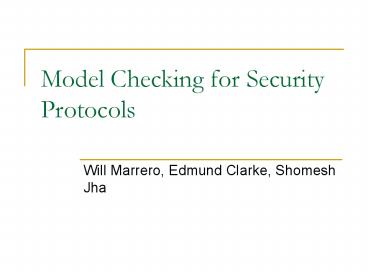Model Checking for Security Protocols - PowerPoint PPT Presentation
Title:
Model Checking for Security Protocols
Description:
Model Checking for Security Protocols. Will Marrero, Edmund Clarke, Shomesh Jha ... Impersonation. Ex: Legitimate Participant. Ex: Compromise Temporary Secrets ... – PowerPoint PPT presentation
Number of Views:70
Avg rating:3.0/5.0
Title: Model Checking for Security Protocols
1
Model Checking for Security Protocols
- Will Marrero, Edmund Clarke, Shomesh Jha
2
Needham-Schroeder Protocol (circa 1996)
- Purpose Authenticate Participants
3
Assumptions
- Perfect Encryption
- The decryption key must be known to encrypt
- No encryption collisions
- Proof offer no protection from poor encryption
implementation!
4
Intruders Ability
- Interception
- Ex
- Impersonation
- Ex
- Legitimate Participant
- Ex
- Compromise Temporary Secrets
- But those secrets should not be revealed by
protocol
5
Security Properties
- Secrecy
- Tracked by two sets in global state
- Correspondence
- If A believes it has completed two protocol runs
with principal B, then principal B must have at
least begun two protocol runs with principal A. - Tracked by counters in global state
6
Atomic Messages
- Keys
- Ex
- Principal Names
- Ex A, B, I
- Nonces
- Ex
- Data
7
Messages and Atomic Messages
- Given A a set of atomic messages, M the set of
all messages is defined inductively
8
Closure of Messages
- Let be a subset of messages
- The closure of is defined by
-
(pairing) -
(projection) -
(encryption) -
(decryption)
9
Principals
- A 4-Tuple
- N the name of the principal
- p a process given as a sequence of actions to be
performed - is a set of known messages, generally
infinite, but from a finite generator set. - B a set of bindings from variables in p to
messages in I
10
Initial Knowledge
- For the intruder
11
Global State
- A 5-Tuple
- is the product of the individual principals
(including the intruder) - difference between number of
times A has initiated a protocol and the number
of times B has finished responding - difference between number of
times A has begun responding and the number of
times B has finished initiating
12
Global State Continued
- A 5-Tuple
- a set of safe secrets. Remains
constant. - a set of temporary secrets. New
secrets generated during the run of the protocol. - The last four values check security constraints.
13
Process
14
Internal Actions
- NEWNONCE(var)
- NEWSECRET(var)
15
Internal Actions
- GETSECRET(val) Intruder Only
16
Internal Actions
- A calls BEGINIT(B),
- B calls ENDRESPOND(A)
- BEGRESPOND/ENDINIT
- Symmetric on
17
Communication Actions
- Send and receives are synchronized
- A process can only send a message if it unifies
with a receive message - Sender must be able to sculpt a message that
matches all existing bindings and expectations - How does the intruder sculpt such a message?
18
Model Checking Algorithm
19
Finding a needle in a haystack
- Decidability of when is probably
infinite? - Normalized Derivation
-
(pairing) -
(projection) -
(encryption) -
(decryption)
Expanding Rules
Shrinking Rules
20
Normalized Derivation
- Following algorithm is guaranteed to terminate
and decide - Start with a generator set
- Apply all possible shrinking rules
- Try all possible sequences of expanding rules
until word size is equal to s - Proves existence
21
An Efficient Approach
- When adding a message to I in
- Apply all possible shrinking rules
- Remove redundant messages
- Result is minimal generator
- Can recursively attempt to build
22
Verification and Attack
23
Verification and Attack
- The lack of correspondence trace reveals the
following attack































